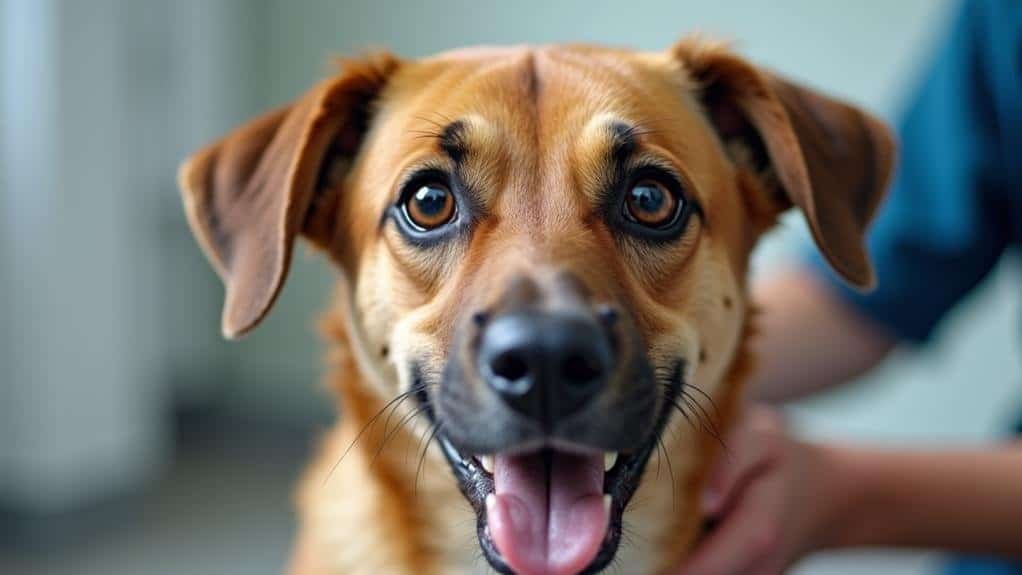Your dog's hyperventilation can be caused by various factors, including excitement, overheating, stress, or underlying health issues. Watch for rapid, shallow breathing, excessive panting, and drooling. If these symptoms persist for more than a few minutes or are accompanied by signs of distress, seek veterinary care immediately. You can help by creating a calm environment, providing water, and avoiding strenuous activities in hot weather. Some breeds are more prone to respiratory issues, so it's crucial to understand your dog's specific needs. By recognizing the signs and knowing when to act, you'll be better equipped to handle this concerning situation. There's more to learn about managing and preventing these episodes.
Understanding Canine Hyperventilation
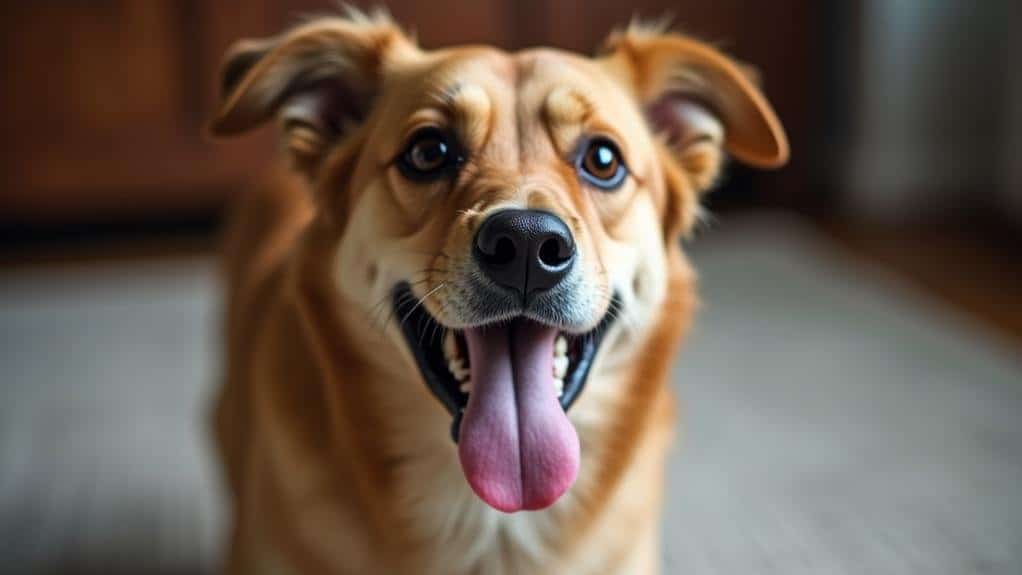
Three key points define canine hyperventilation: rapid breathing, potential underlying causes, and associated symptoms. When your dog's breathing becomes unusually fast or deep, it's crucial to understand what's happening and why.
1. Recognizing Hyperventilation:
Your furry friend may be experiencing breathing difficulties if you notice:
- Rapid, shallow breaths
- Excessive panting with an open mouth
- Increased heart rate
- Drooling more than usual
2. Common Triggers:
Hyperventilation in dogs can stem from various factors, including:
- Anxiety or stress
- Overheating, which can lead to heat stroke
- Pain or discomfort
- Underlying medical issues
3. When to Worry:
While some panting is normal, especially after exercise or in warm weather, prolonged hyperventilation can be a serious condition.
If you notice bluish gums or your dog seems distressed, it's time for immediate veterinary attention.
Common Causes of Rapid Breathing
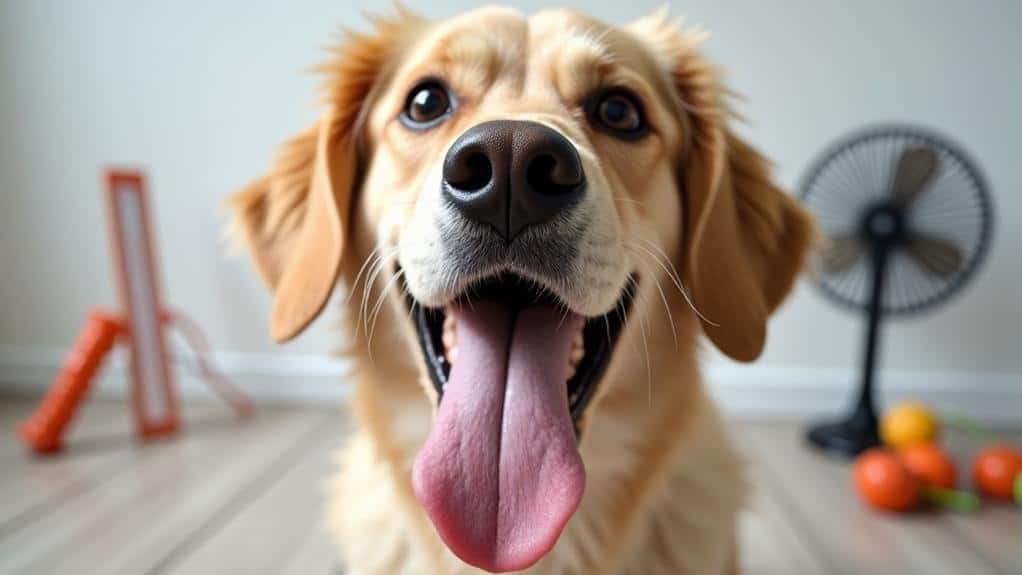
Rapid breathing in dogs can stem from various sources, ranging from benign to potentially serious. Understanding these causes can help you determine when your furry friend needs veterinary attention.
1. Excitement and Exercise
Your dog's hyperventilation might simply be a result of excitement or physical activity. It's normal for dogs to breathe rapidly after a vigorous play session or when they're thrilled to see you.
However, if this rapid breathing persists long after the excitement has passed, it's worth monitoring closely.
2. Overheating
Dogs don't sweat like we do; they rely on panting to cool down. If your pup's breathing remains rapid and shallow, especially on hot days or after sun exposure, they might be overheating.
This can quickly escalate to heat stroke, so it's essential to help them cool off and seek veterinary care if symptoms persist.
3. Stress and Anxiety
Just like humans, dogs can experience stress-induced rapid breathing. Loud noises, unfamiliar environments, or separation anxiety can trigger this response.
Identifying and minimizing stressors can help alleviate your dog's respiratory distress.
Recognizing Symptoms and Warning Signs
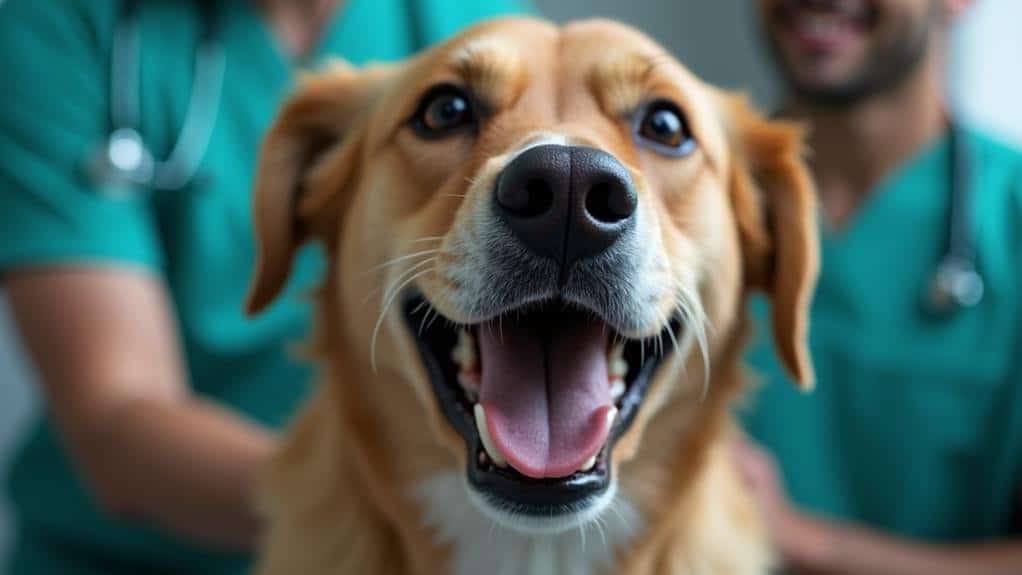
While understanding the causes of rapid breathing is important, it's equally vital to recognize the symptoms and warning signs of hyperventilation in dogs.
As a pet owner, you'll want to keep a close eye on your furry friend's breathing patterns to catch any potential issues early.
Signs of hyperventilation in dogs include:
- Rapid, shallow breaths
- Open-mouth panting
- Excessive drooling
- Pale or blue gums (a critical warning sign!)
- Weakness or lethargy
- Shaking or pacing
If you notice your dog exhibiting these symptoms, it could indicate underlying distress or health problems.
Don't panic, but do take it seriously. Excessive panting, especially when combined with other signs, may require urgent care or medical attention.
When to Seek Veterinary Care
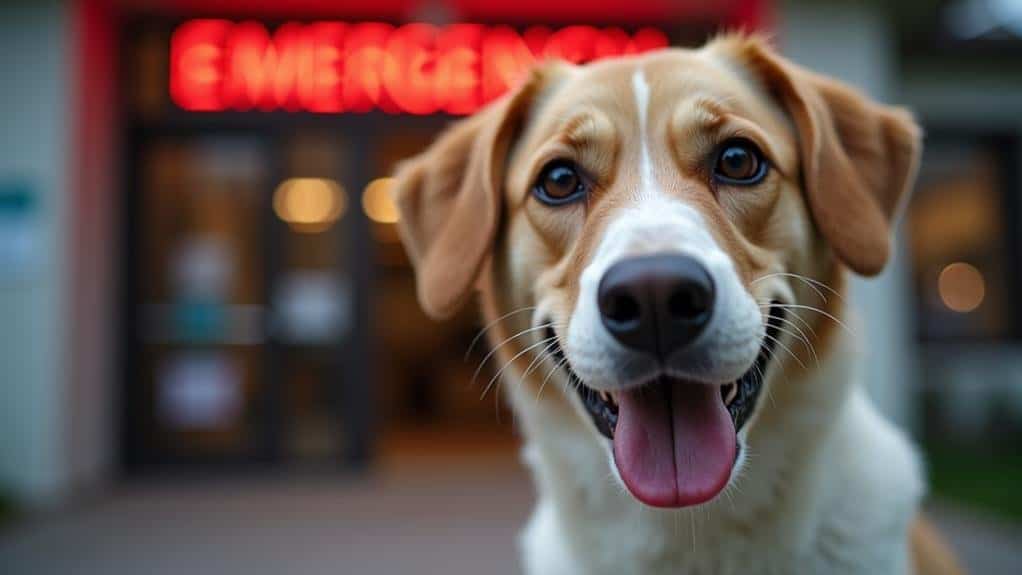
As a responsible pet owner, knowing when to seek veterinary care for your hyperventilating dog is essential.
While some cases of hyperventilation may resolve on their own, there are situations where immediate medical attention is vital.
Here's when you should seek veterinary attention immediately:
- Persistent hyperventilation: If your dog's rapid breathing lasts for more than a few minutes, it's time to worry. This could be a sign of a serious medical issue that requires urgent care.
- Signs of distress: Watch for weakness, lethargy, pale or blue gums, vomiting, shaking, or unresponsiveness. These symptoms, combined with hyperventilation, warrant a trip to the vet.
- Post-stress or overheating: If your pup's breathing doesn't return to normal after exposure to stressful situations or high temperatures, it's best to consult a professional.
- Suspected underlying condition: Hyperventilation can be a symptom of metabolic acidosis or respiratory problems. Don't take chances – get your furry friend checked out.
At-Home Care and Management Techniques
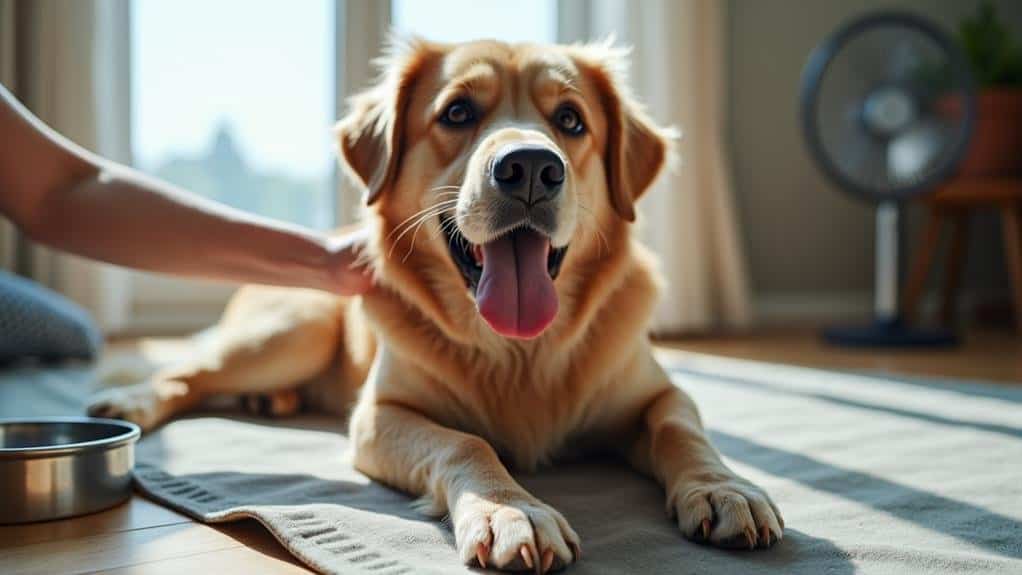
Managing your dog's hyperventilation at home can be vital in providing immediate relief and preventing further complications. When you notice your furry friend breathing rapidly, it's important to create a calm environment away from stressors. This helps stabilize their breathing patterns and reduces anxiety.
During hot weather, hydration and temperature control are key. Offer your dog cool water and provide shade to prevent heat stroke, which can worsen hyperventilation.
You can also use calming products to soothe your pup's nerves:
- Anxiety wraps or vests
- Calming treats or supplements
- Pheromone diffusers
- Soft, soothing music
Monitor your dog's behavior closely. If hyperventilation persists for more than a few minutes or is accompanied by severe symptoms, seek urgent veterinary attention.
Remember, while anxiety medications may be prescribed by your vet, they shouldn't be your first line of defense.
Long-term management involves gradual desensitization to stressful situations. This can help reduce anxiety-related hyperventilation over time.
Preventing Hyperventilation Episodes
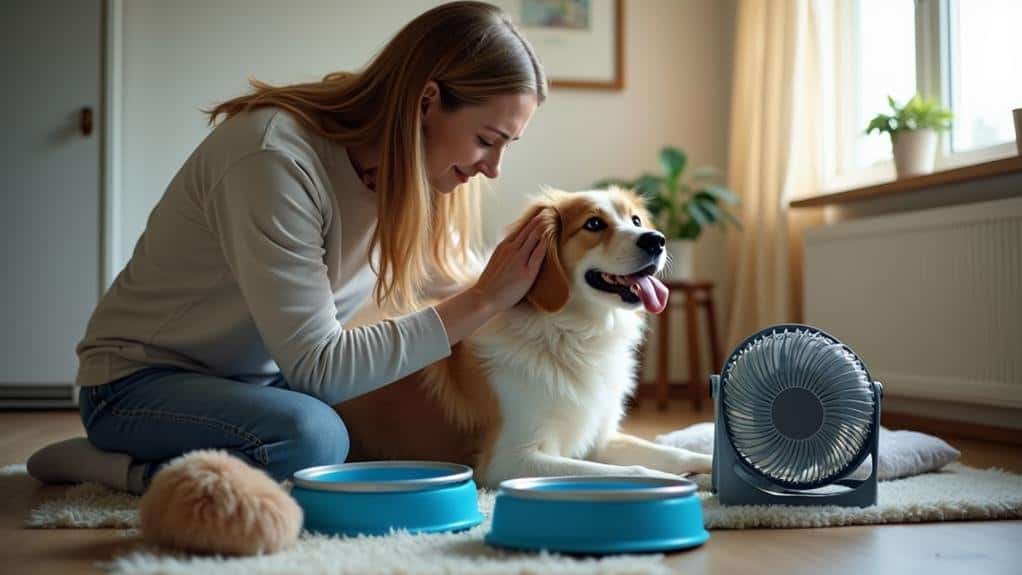
Preventing hyperventilation episodes in dogs often requires a proactive approach. To keep your furry friend calm and comfortable, consider these strategies:
1. Environmental Management:
Ensure your dog always has access to fresh water, especially during hot and humid weather. Avoid strenuous activities when it's too warm outside, as overheating can trigger hyperventilation.
Create a soothing environment by using calming products like anxiety wraps or pheromone diffusers, which can help reduce stress.
2. Gradual Exposure and Training:
Slowly introduce your dog to potentially stressful situations, using positive reinforcement techniques to build their resilience. This approach can help them cope better with anxiety triggers in the future.
3. Exercise and Mental Stimulation:
Regular physical activity and brain games can work wonders in preventing hyperventilation. A tired, mentally satisfied dog is less likely to experience anxiety-induced breathing issues.
4. Vigilant Monitoring:
Keep a close eye on your pup for signs of stress or overheating. If you notice any concerning symptoms, take immediate action to cool them down or remove them from the distressing environment.
Breed-Specific Considerations

When it comes to hyperventilation in dogs, breed-specific factors play an essential role in both the likelihood and management of these episodes.
As a pet owner, it's important to understand how your dog's breed might influence their breathing patterns and potential for hyperventilation. Brachycephalic breeds, like Bulldogs and Pugs, are more prone to respiratory issues due to their short snouts, making them susceptible to hyperventilation in stressful situations or hot weather.
Consider these breed-specific factors when addressing hyperventilation:
- Small and toy breeds may experience anxiety-induced hyperventilation during routine changes.
- Larger breeds might hyperventilate due to underlying health issues like heart problems or obesity.
- Breeds with a history of laryngeal paralysis may need urgent care for airway obstruction.
- Dogs with anxiety disorders, regardless of breed, may require tailored behavioral interventions.
If you have a brachycephalic breed, be extra vigilant during hot weather and limit their exposure to stressors.
For larger breeds, maintain a healthy weight and regular check-ups to catch potential health issues early.
If your dog has a history of anxiety or respiratory problems, work with your vet to develop a treatment plan that addresses their specific needs.
Long-Term Health Implications
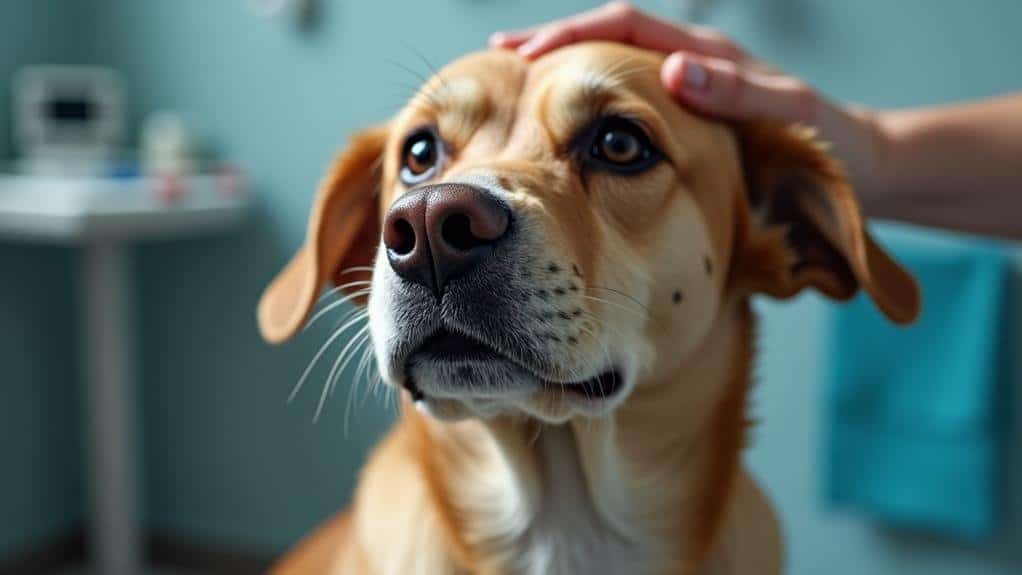
A dog's long-term health can be considerably impacted by recurrent episodes of hyperventilation. When your furry friend experiences frequent bouts of rapid breathing, it's not just a momentary discomfort – it can lead to serious consequences if left unchecked.
First, let's consider the immediate risks:
- Decreased oxygen levels in the blood
- Potential organ dysfunction due to hypoxia
These urgent care situations require prompt attention to prevent long-term damage.
But that's not all – persistent hyperventilation might be a red flag for underlying health issues, such as:
- Metabolic acidosis
- Laryngeal paralysis
- Heart disease
Ongoing veterinary care and monitoring are essential in these cases.
Additionally, stress and anxiety-induced hyperventilation can wreak havoc on your pup's well-being. Chronic health problems may develop, weakening their immune system and opening the door to other illnesses.
Here's where it gets tricky: dogs may develop a conditioned response to triggers, leading to increased anxiety and avoidance behaviors. This can make future care challenging, but don't worry!
Early intervention is key to improving your dog's long-term health prognosis. By addressing hyperventilation promptly, you're giving your four-legged friend the best chance at a happy, healthy life.
Frequently Asked Questions
How Do You Treat a Dog That Is Hyperventilating?
If your dog's hyperventilating, stay calm. Remove them from stressors, provide a cool environment, and offer water. Monitor their behavior closely. If it persists or they show signs of distress, don't wait—contact your vet immediately for professional guidance.
Is Dog Hyperventilating an Emergency?
Yes, dog hyperventilation can be an emergency. You should treat it seriously, especially if it lasts more than a few minutes or comes with other symptoms. Don't delay seeking veterinary care, as early intervention is essential.
How Long Is Too Long for a Dog to Hyperventilate?
You shouldn't let your dog hyperventilate for more than a few minutes without improvement. If it lasts over 15-20 minutes, it's too long. Seek immediate vet care, especially if you notice signs of distress like weakness or blue gums.
How to Help a Dog Struggling to Breathe?
If your dog's struggling to breathe, stay calm and remove them from stress. Check their gums, keep them cool, and watch for other symptoms. If it persists or worsens, don't wait – seek immediate veterinary care.
Conclusion
In managing your dog's hyperventilation, you're now equipped with essential knowledge. Remember, while some causes are benign, others require immediate attention. Keep a close eye on your furry friend, and don't hesitate to contact your vet if you're unsure. With proper care and awareness, you'll be better prepared to handle these scary moments. Stay calm, act swiftly when needed, and cherish those panting-free cuddles with your four-legged companion!

